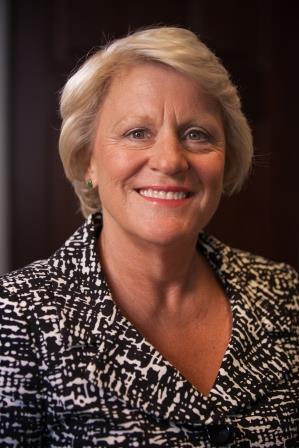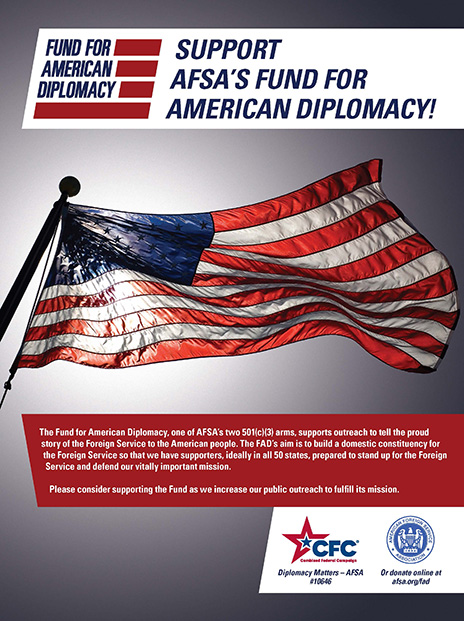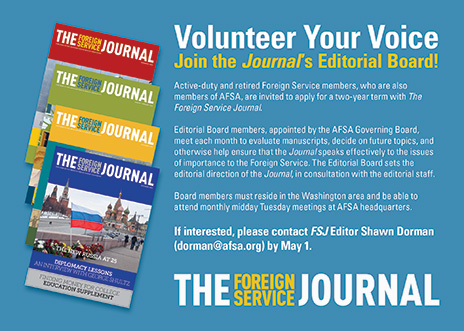Working Together to Manage Risk
President's Views
BY BARBARA STEPHENSON

I write as we are awaiting the arrival of a new Secretary of State and looking forward to offering the traditional welcome by the AFSA president and Foreign Service members in the C Street lobby. That lobby, fittingly, also houses the memorial plaques bearing the names of 248 Foreign Service colleagues who died serving our country abroad.
I hope to get a chance to point out those plaques to our new Secretary by way of explaining what we in the Foreign Service do—namely, we typically spend two-thirds of our careers deployed worldwide, including to difficult and dangerous posts. We know that not everyone makes it home. We accept that reality, recognizing that we must take reasonable risks if we are to maintain an enduring American presence in almost every country in the world.
Our enduring presence is the foundation of strong American global leadership, something nine in 10 Americans support. Widespread withdrawal is simply incompatible with strong global leadership. As former NATO Secretary General Anders Fogh Rasmussen put it, “When America retrenches and retreats, it leaves behind a vacuum, and that vacuum is filled by bad guys.”
This must-read edition of the FSJ, which looks at Diplomatic Security on its 100th anniversary, is anchored by former DS Assistant Secretary Greg Starr’s article “Securing Diplomacy for the Next Quarter Century.” I am pleased to see the FSJ pay tribute to the vital role our DS colleagues play in securing diplomacy.
To lead, we must be present; and to be present, we must manage the risks of our overseas deployment as effectively as possible so that the American Foreign Service team never has to walk off the field and forfeit the game.
How do we make sure the U.S. Foreign Service continues to show up where we are needed? One of the most important steps, in my view, is to act and think like a team, to recognize that we are all in this together. That means avoiding the trap of framing decisions in “us versus them” terms—of political officers (like me, for example) complaining that “the RSO won’t let me do my job.”
To lead, we must be present; and to be present, we must manage the risks of our overseas deployment.
Of course I need to get out of the embassy compound and engage face-to-face with host-nation counterparts. How else will I assess accurately and forge the partnerships needed to make common cause? But that still leaves plenty of room for input from the RSO team on how to mitigate risk and engage safely. Improvised explosive devices a real problem? Perhaps I can postpone my trip until later in the day, when others will have already traveled my proposed route. Too hard for DS to secure the route to my proposed meeting? Maybe a new meeting site can be arranged.
This kind of dialogue underpins the State Department’s relatively new Vital Presence Validation Process (known as VP2), which requires an annual review of the risks and benefits of maintaining an American presence in the 33 most high-risk, high-threat posts. VP2 produces a clear-eyed written assessment of how the compelling policy reasons for being present stack up against the risks that cannot be reasonably and cost-effectively mitigated.
Although VP2 is a Washington-based process to determine the strategic decision of where to maintain an American presence, the framework can also be highly useful for embassy emergency action committees (EACs) weighing operational and tactical decisions.
Should a specific trip take place? Ask EAC members to both articulate the policy benefits of going ahead and lay out the risks, including reasonable steps that can be taken to mitigate the risks. Report the results of the EAC’s deliberations and decision in a cable. If the risk is high, or the judgment call very difficult, consider seeking Washington guidance.
But, above all, have a dialogue, work as a team. Assume everyone is committed to maintaining the robust Foreign Service presence on which strong American global leadership depends.



